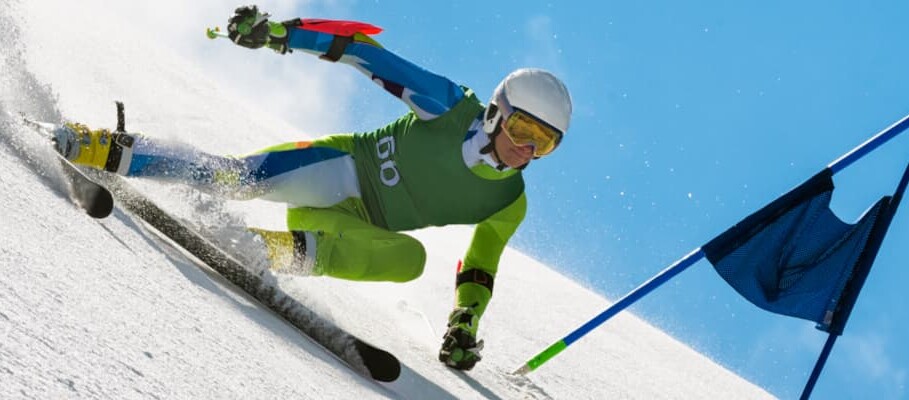Materials: The basis for maximum performance
Choosing the right materials is crucial for the properties of a ski or snowboard. Traditionally, wooden cores were used, but modern models often rely on combinations of wood, fibreglass, Titanal and special plastics. These materials give the equipment the desired flexibility, torsional rigidity and damping. One trend that has become increasingly important in recent years is the use of nanotechnology. By manipulating materials at an atomic level, properties such as strength, weight and sliding properties can be optimised.
In addition to ensuring flexibility, torsional rigidity and damping, thermal insulation in particular plays a key role. Ski boots, for example, consist of several layers that ensure optimum thermal insulation. Materials such as Thinsulate and Gore-Tex are particularly noteworthy here. Thinsulate is a high-performance insulating material that provides excellent thermal insulation even in thin layers. Gore-Tex, on the other hand, is a breathable and waterproof membrane material that transports moisture to the outside and at the same time keeps moisture out.
In the case of skis and snowboards themselves, thermal insulation is often achieved by using special foams on the inside. These ensure that feet stay warm even in cold temperatures. The bases also play an important role in gliding properties and heat transfer. Modern rubbers are highly wear-resistant and offer an optimum balance between gliding properties and grip.
In addition to thermal insulation, the materials used also influence the weight, service life and environmental compatibility of the products. More and more manufacturers are focussing on sustainable materials and production processes in order to reduce their ecological footprint.
Production process: from the idea to the finished product
The production of winter sports equipment is a multi-stage process that begins in the development department. This is where the first prototypes are created, which undergo extensive testing for functionality and performance. Engineers and designers work closely together to achieve the optimum combination of performance, comfort and design.
Series production usually begins with the manufacture of the core. This often consists of a combination of wood, foam and other materials. Modern CNC milling machines enable high-precision machining of the core moulds. The core is then connected to the side walls. These connect the core to the base and ensure the torsional rigidity of the ski or snowboard.
The base is applied to the core in a special process. A high-quality plastic is melted under high pressure and temperature and bonded to the core. The structure of the base has a significant influence on the gliding properties and durability of the product.
The final finishing is carried out in several steps. These include grinding, polishing and applying the structure to the flooring. Modern laser technology such as CNC milling makes it possible to mill precise structures into the rubber that further optimise the gliding properties.
The role of manual labour should not be underestimated. Especially in the production of high-quality custom skis and snowboards, manual labour plays a decisive role. Experienced craftsmen can respond to individual customer requests and optimise the quality of the products through precision work. For example, they take care of the final assembly, the adjustment of the bindings and the final quality control.
Summary of the production steps:
- Prototype development: Creation of initial models and testing.
- Core production: CNC-milled cores made of wood, foam or other materials.
- Connection of core and side panels: Gluing or screwing.
- Covering application: Application of the covering under high pressure and temperature.
- Finishing: Sanding, polishing, structuring.
- Final assembly: Assembly of all components, adjustment of the bindings.
- Quality control: Testing for functionality, safety and workmanship.
Quality assurance: High demands on precision and safety
Quality assurance plays a crucial role in the production of winter sports equipment. Each product is subjected to a variety of tests to ensure that it meets the high safety and performance requirements. Both the mechanical properties and the quality of the surfaces are checked.
Sustainable winter sports equipment: responsibility for the environment and society
The production of winter sports equipment also has an impact on the environment. In recent years, awareness of sustainability has increased significantly in the industry. More and more manufacturers are using recycled materials, reducing their energy consumption and optimising their production processes. Consumers also play an important role: by purchasing products with appropriate certificates such as Bluesign, they can contribute to a more sustainable winter sports industry.
Conclusion
The production of winter sports equipment is a fascinating process that requires a combination of tradition, innovation and precision. The use of state-of-the-art technologies and high-quality materials results in products that meet the highest standards. As consumers, we should realise that there is a complex production chain behind every ski and every snowboard. By paying attention to quality and sustainability, we can help to ensure that this sport is preserved for future generations.
